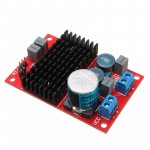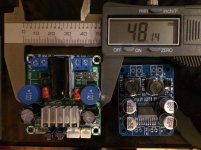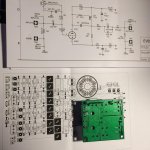Tyger23 on the PE site recommended not sync'ing the boards as long as they use the same power supply in one thread. IIRC, in another thread, he didn't recommend multiple amps in the same chassis.I would be interested in posts about beat noise actually being the problem causing audible noise, so I hoped for a PE link, but my guess is it is all in theory like the posts here. TI almost advices to not connect 8 ampchips in post I quoted and use 8 masters in same amp enclosure instead. Maybe the audibility is very low if it does occur and getting the 8 chip amp 1 master and 7 slaves approved by Fcc is far bigger problem. A little spread in switchingfrequencies might even help to stay within Fcc limits LOL
Can't remember posts about actual beat noise problems with SystemD irs2092 either, so might not be identified or audible as a problem or only becomes really audible with megawatt amplifiers or very high gain ? SystemD LiteAmp is very low gain.
I would be very appreciative if someone can clarify:
TPA 3116 in PBTL says 100W at 2ohms (combined to a single channel)
...which means 50watts at 4ohms? (still combined to a single channel)
But in BTL, it can already 50watts at 4ohms for TWO channels!?
I thought if you combined the channels, you would get double power output? (i.e. 100watts at 4ohm)
TPA 3116 in PBTL says 100W at 2ohms (combined to a single channel)
...which means 50watts at 4ohms? (still combined to a single channel)
But in BTL, it can already 50watts at 4ohms for TWO channels!?
I thought if you combined the channels, you would get double power output? (i.e. 100watts at 4ohm)
You parallel a bridged amplifier. Parallel you can supply ~same voltage but double the current(amperes). Datasheet mentions maximum output can be reached for 3.2 ohm load in BTL, so BTL current limit seems to be at 3.2 ohm (7A), for 4 ohm the power isn't limited by current.
edit: power could always also be temperature limited, since datasheet mentions 7.5A max, it may be tepmerature that limits power a little.
edit: power could always also be temperature limited, since datasheet mentions 7.5A max, it may be tepmerature that limits power a little.
Last edited:
I would be very appreciative if someone can clarify:
TPA 3116 in PBTL says 100W at 2ohms (combined to a single channel)
...which means 50watts at 4ohms? (still combined to a single channel)
But in BTL, it can already 50watts at 4ohms for TWO channels!?
I thought if you combined the channels, you would get double power output? (i.e. 100watts at 4ohm)
Combinining two amps rated 50W/4Ohm yields 100W/2Ohm.
https://en.wikipedia.org/wiki/Ohm's_law
Okay thanks guys for replying.
I think I understand, please correct me if I'm wrong.
The only benefit of parallel is that it can supply more current to the load, if the load demands it. However (in the case of TPA3116) if the load is always 4 ohms, then there is no benefit to using PTBL over just BTL since they will both draw the same current, and a single channel of BTL can already handle it.
Basically what I'm trying to do feed a single 6 ohm speaker that is rated for 100W RMS. Do you guys have any recommendations as to how to do this? I thought TPA 3116 in PTBL would give it 100W, but now I see that's not the case.
The speaker is Sony Core Series 5. I plan to power them separately in mono (each would have their own amp).
I think I understand, please correct me if I'm wrong.
The only benefit of parallel is that it can supply more current to the load, if the load demands it. However (in the case of TPA3116) if the load is always 4 ohms, then there is no benefit to using PTBL over just BTL since they will both draw the same current, and a single channel of BTL can already handle it.
Basically what I'm trying to do feed a single 6 ohm speaker that is rated for 100W RMS. Do you guys have any recommendations as to how to do this? I thought TPA 3116 in PTBL would give it 100W, but now I see that's not the case.
The speaker is Sony Core Series 5. I plan to power them separately in mono (each would have their own amp).
With a 6-ohm speaker, PBTL is not likely to provide any higher output power drive - assuming that you have adequate cooling and a decent power supply.
With correctly implemented TPA3116 board and a good 24V power supply, you should be able to get somewhere between 35W to 40W per channel at reasonably low distortion levels into a 6-ohm speaker. This is probably more power than you need for listening to music in a small-to-medium sized room, and should be able to drive the speakers you mentioned perfectly fine.
If you need more power into 6-ohm speakers, you would have to chose an amplifier with higher supply voltage and higher output power capability. There are quite a few TDA7498 and TDA7498E boards out there and they are only slightly more expensive than TPA3116 boards. You would need a 32V or 36V DC supply based on the particular configuration of the board you choose.
Amazon has this TDA7498E board on sale for $14.62 right now which is a great price. You can use it with a 36V 200W power supply like this one if you have some basic electrical safety skills. Or you can use it with a power adapter like this one which may not get you the full potential of the 7498E but should still generate plenty of volume.
If you want to power the speakers separately, you would need two TDA7498 boards, but then you can use a lower rated power adapter like this for each amp.
With correctly implemented TPA3116 board and a good 24V power supply, you should be able to get somewhere between 35W to 40W per channel at reasonably low distortion levels into a 6-ohm speaker. This is probably more power than you need for listening to music in a small-to-medium sized room, and should be able to drive the speakers you mentioned perfectly fine.
If you need more power into 6-ohm speakers, you would have to chose an amplifier with higher supply voltage and higher output power capability. There are quite a few TDA7498 and TDA7498E boards out there and they are only slightly more expensive than TPA3116 boards. You would need a 32V or 36V DC supply based on the particular configuration of the board you choose.
Amazon has this TDA7498E board on sale for $14.62 right now which is a great price. You can use it with a 36V 200W power supply like this one if you have some basic electrical safety skills. Or you can use it with a power adapter like this one which may not get you the full potential of the 7498E but should still generate plenty of volume.
If you want to power the speakers separately, you would need two TDA7498 boards, but then you can use a lower rated power adapter like this for each amp.
Last edited:
With a 6-ohm speaker, PBTL is not likely to provide any higher output power drive - assuming that you have adequate cooling and a decent power supply.
With correctly implemented TPA3116 board and a good 24V power supply, you should be able to get somewhere between 35W to 40W per channel at reasonably low distortion levels into a 6-ohm speaker. This is probably more power than you need for listening to music in a small-to-medium sized room, and should be able to drive the speakers you mentioned perfectly fine.
If you need more power into 6-ohm speakers, you would have to chose an amplifier with higher supply voltage and higher output power capability. There are quite a few TDA7498 and TDA7498E boards out there and they are only slightly more expensive than TPA3116 boards. You would need a 32V or 36V DC supply based on the particular configuration of the board you choose.
Amazon has this TDA7498E board on sale for $14.62 right now which is a great price. You can use it with a 36V 200W power supply like this one if you have some basic electrical safety skills. Or you can use it with a power adapter like this one which may not get you the full potential of the 7498E but should still generate plenty of volume.
If you want to power the speakers separately, you would need two TDA7498 boards, but then you can use a lower rated power adapter like this for each amp.
Thank you very much ravels!
Based on your description, it seems 35W-40W would be more then enough (I typically just watch movies at night at low volume).
You also freed me from the restriction of purchasing PBTL configured TPA3116.
Would you have any suggestions as to configuring TPA3116 with bluetooth? I keep seeing the "Sanwu" ones being recommended. But I also read that sometimes the bluetooth antenna is too close to the amp. I thought maybe it's better to have a separate bluetooth board.
https://www.aliexpress.com/item/New...er-Audio-Amplifier-Board-BTL/32699597173.html
Have anyone tried these? How do they compare to Sanwu TPA3118? I like that these support balanced input and has a heatsink.
Have anyone tried these? How do they compare to Sanwu TPA3118? I like that these support balanced input and has a heatsink.
Attachments
https://www.aliexpress.com/item/New...er-Audio-Amplifier-Board-BTL/32699597173.html
Have anyone tried these? How do they compare to Sanwu TPA3118? I like that these support balanced input and has a heatsink.
I tested one of these boards at bench, and found that it was set in slave mode; I really don't know if all the boards have the same setting; after the modification described in post #9709 the board worked fine (at bench, because I rely more on my oscilloscope and on my distortion analyzer than on my old ear).
http://www.tij.co.jp/jp/lit/ds/slos708/slos708.pdf I stumbled across this version of the datasheet by accident, it has the connection of the sync for master/slave shown correctly.
It might save someone the aggravation that I had trying to get a dual 3116 board to work.
It might save someone the aggravation that I had trying to get a dual 3116 board to work.
It has a version of synch without any filter/any parts, funny
Yes, I thought there would have been a resistor 1 or 10k, but back in the bad old days a lot of ttl didn't have current limiting resistors. I just removed the cog chip cap to ground, and left the resistor. The chips started running in sync, and all was good.
I ordered a couple of these TPA3116 PBTL to test. If they work out, making a Eagle footprint for it.
The terminal blocks and headers I'll remove. Those will become 'pins' using heavy bus wire.
We'll see how it goes. There is a newer version with a film input cap. I'll remove the existing two polars and replace too on this earlier board. The large 2200uF filter cap will also have to be replaced. Its rated 25V and I'm running 24V. The other two radial ps caps rated 35v so ok. The pcb is setup for heatsink screws but heatsink is untapped. So that too.
Shown here next to the ever popular $6 miracle amp.
This is for a hybrid 6SN7/ D-class monobloc. Have different photos running now. I love these boards.
-
The terminal blocks and headers I'll remove. Those will become 'pins' using heavy bus wire.
We'll see how it goes. There is a newer version with a film input cap. I'll remove the existing two polars and replace too on this earlier board. The large 2200uF filter cap will also have to be replaced. Its rated 25V and I'm running 24V. The other two radial ps caps rated 35v so ok. The pcb is setup for heatsink screws but heatsink is untapped. So that too.
Shown here next to the ever popular $6 miracle amp.
This is for a hybrid 6SN7/ D-class monobloc. Have different photos running now. I love these boards.
-
Attachments
Phasesplitter in tube section ?
Why do you think the bigger ampboard might be better ? How does bottom pcb look ?
The tube make great simple low distortion CFP hybrid sound. Rat nest bottom pcb shown here. Dims are mtg holes. Power is +24 and -24v so tube sees 48v total.
-
Attachments
The terminal blocks and headers I'll remove. Those will become 'pins' using heavy bus wire.
Why ? You know what the best connection is don't you ? I have my doubts at the quality of those specific connectors blocks (probably ferro or famous chinese "any-metal mix") but Phoenix ones are better than soldering to pins. More flexible too and less problems with mechanical stress.
Last edited:
here is link to zip files schematic/plots early prototype using 12au7 and $6 tpa3118 board.
http://www.diyaudio.com/forums/inst...ment-speakers-almost-extinct.html#post4854659
-
http://www.diyaudio.com/forums/inst...ment-speakers-almost-extinct.html#post4854659
-
Why ? You know what the best connection is don't you ? I have my doubts at the quality of those specific connectors blocks (probably ferro or famous chinese "any-metal mix") but Phoenix ones are better than soldering to pins. More flexible too and less problems with mechanical stress.
My background is high reliabilty mil/automotive and extreme environment oil-gas. Screw terminal connections are not allowed.
I prefer soldered anyway for this class-d app, guaranteed low z power connect.
-
- Home
- Amplifiers
- Class D
- TPA3116D2 Amp


